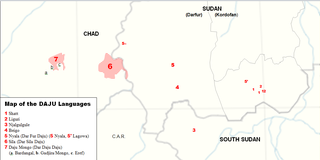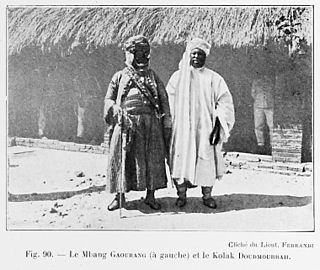Related Research Articles

Darfur is a region of western Sudan. Dār is an Arabic word meaning "home [of]" – the region was named Dardaju while ruled by the Daju, who migrated from Meroë c. 350 AD, and it was renamed Dartunjur when the Tunjur ruled the area. Darfur was an independent sultanate for several hundred years until 1874, when it fell to the Sudanese warlord Rabih az-Zubayr. The region was later invaded and incorporated into Sudan by Anglo-Egyptian forces in 1916. As an administrative region, Darfur is divided into five federal states: Central Darfur, East Darfur, North Darfur, South Darfur and West Darfur. Because of the War in Darfur between Sudanese government forces and the indigenous population, the region has been in a state of humanitarian emergency and genocide since 2003. The factors include religious and ethnic rivalry, and the rivalry between farmers and herders.
The Kujargé language is spoken in seven villages in eastern Chad near Jebel Mirra, and in villages scattered along the lower Wadi Salih and Wadi Azum in Darfur, Sudan. It is estimated to have about 1000 speakers.

The Daju languages are spoken in isolated pockets by the Daju people across a wide area of Sudan and Chad. In Sudan, they are spoken in parts of the regions of Kordofan and Darfur, in Chad they are spoken in Wadai. The Daju languages belong to the Eastern Sudanic subfamily of Nilo-Saharan.

Batha is one of the 23 regions of Chad, located in the centre of the country. It is composed of what was formerly Batha Prefecture with some slight boundary adjustments. The capital of the region is Ati.

Guéra is one of the 23 regions of Chad, created in 2002 from the former Guéra prefecture. The region's capital is Mongo. As of 2009, the population of the region was 553,795.

Ouaddaï or Wadai is a region of Chad, located in the south-east of the country, with its capital at Abéché. Prior to 2002 it was known as Ouaddaï Prefecture; in 2008 the southern portions of Ouaddaï were split off to become the new Sila Region.
Dar Sila is the name of the wandering sultanate of the Dar Sila Daju, a multi-tribal ethnic group in Chad and Sudan. The number of the people in this group exceeds 50,000. They speak the Sila language, a Nilo-Saharan language. Most members of this ethnic group are Muslims.
Berti is an extinct Saharan language formerly spoken in northern Sudan, specifically in the Tagabo Hills, Darfur, and Kurdufan. Berti speakers migrated into the region with other Nilo-Saharan speakers, such as the Masalit and Daju, who were agriculturalists practicing varying degrees of animal husbandry. They settled in two separate areas: one north of Al-Fashir, while the other had continued eastward, settling in eastern Darfur and western Kurdufan by the nineteenth century. The two groups did not appear to share a common identity, the western group differing noticeably in its cultivation of gum arabic. By the 1990s, Sudanese Arabic had largely replaced Berti as a native language.
The Daju people are a group of seven distinct ethnicities speaking related languages living on both sides of the Chad-Sudan border and in the Nuba Mountains. Separated by distance and speaking different languages, at present, they generally have little cultural affinity to each other.
Mongo, also called Nkundo or Mongo-Nkundu, is a Bantu language spoken by several of the Mongo peoples in the Democratic Republic of the Congo. Mongo speakers reside in the north-west of the country over a large area inside the curve of the Congo River. Mongo is a tonal language.
Beigo is an extinct Daju language once spoken in Sudan by the Baygo people, numbering some 850 in the late twentieth century. Similar to Darfur Daju, it is classified as part of the Western Daju family of languages.

Sila or Dar Sila is a region of Chad, located in the south-east of the country. It was created in 2008 from the departments of Sila and Djourf Al Ahmar which were previously part of Ouaddaï Region. The capital of the region is Goz Beïda.
Nyala, also known as Dar Fur, Darfur Daju, Daju Darfur, Beke, Dagu, Daju Ferne and Fininga, is an Eastern Sudanic language of Sudan, one of three closely related languages in the area called "Daju". It is spoken near Nyala, the capital of South Darfur province by the Dar Fur Daju people. There are two divergent dialects: Nyala and Lagowa.
Daju Mongo, also Wadai Daju or Dar Daju Daju, is an Eastern Sudanic language, one of three closely related languages in the area called "Daju". It is spoken in Chad by the Dar Daju Daju people near the Darfur border. There are three dialects, Bardangal, Eref, and Gadjira.
Nyolge or Nyagulgule (Njalgulgule) is a Daju language of the Western Daju, spoken in a single village in South Sudan.
The Dar Daju Daju are an ethnic group numbering 34,000 people in the Guéra Region of southwestern Chad. They are one of seven distinct ethnicities comprising the Daju people. They speak the Daju Mongo language and are mostly Muslim.
The Dar Fur Daju are an ethnic group in the Sudan. They are one of seven distinct ethnicities comprising the Daju people. They speak the Nyala language. They live in Southern Darfur in the Sudan in the Daju Hills 40 km northeast of Nyala - although most of this population has fled to Chad as a result of the Darfur Conflict. There is also a small population of Dar Fur Daju near the city of Lagowa in the Nuba Hills. Their total population numbers 98,000 (2017). They are mostly Muslim.

Muhammad Salih bin Yusuf, known as Dud Murra or Dudmurrah, was the last independent ruler, or kolak, of the Wadai Empire. He allied with the Sanusi, powerful traders of the eastern Sahara, and with the Sultan of Darfur to resist French aggression in the eastern Sahel, but was defeated. His sultanate was incorporated in the French military territory of Chad.

The Daju kingdom was a medieval monarchy that existed in Darfur (Sudan) from possibly the 12th–15th century. Its name stems from the Daju people, the ruling ethnic group. The Daju were eventually ousted from power by the Tunjur and the last Daju king subsequently fled to present-day Chad. The sources for the Daju kingdom are almost entirely local traditions collected in the 19th and 20th century and mentions by medieval Arab historians.
The Kujarke people are a little-known ethnic group of the Ouaddaï Region in eastern Chad and South Darfur, Sudan. They speak Kujargé, a divergent, unclassified Afro-Asiatic language. Their current population and locations are unknown due to the war in Darfur. Furthermore, they have not been previously recorded as a separate ethnic group by any government or foreign aid organization.
References
- ↑ Daju Dar Sila at Ethnologue (18th ed., 2015) (subscription required)